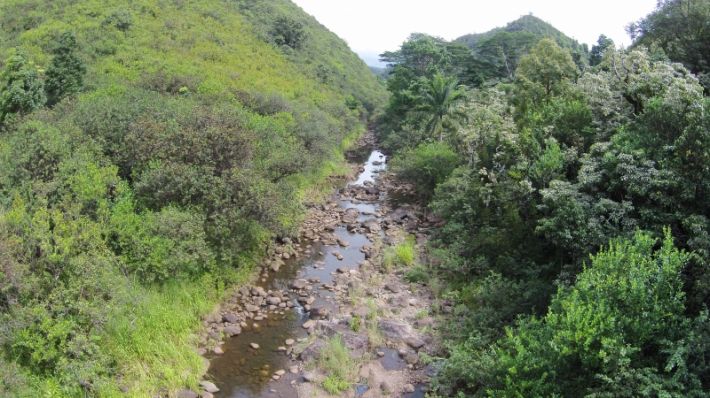Locals and tourists alike traverse and paddle under the famed and historic Hale‘iwa Rainbow Bridge which extends over Anahulu Stream on the North Shore of O‘ahu.
Many, however, may not realize that Anahulu Stream, stretching 7.1 miles from Anahulu Valley, is the longest watercourse on the island. The traditional and historic sites within Anahulu Valley provide a link to its past history and use.
The valley, recently acquired by Kamehameha Schools to preserve the cultural resources located within it, is tucked away in the mountains behind Hale‘iwa Town, where traditional and historic sites link Hawai‘i’s people to its past history and use.
The mouth of Anahulu Valley was traditionally noted as a major population center in the moku of Waialua.
During the 15th and 16th centuries the use of rock shelters as temporary residences began within the valley. Some were still being used as intermittent habitations in the 17th century.
By the beginning of the 18th century, the use of rock shelters shifted from temporary (or seasonal) habitation to permanent habitation with the inclusion of penned domesticated animals.
Following the conquering of O‘ahu by Kamehameha I, the lower portions of Anahulu Valley underwent major transformations in its settlement pattern, increasing the level of economic activity while the upper reaches were abandoned.
At the expense of producing basic subsistence crops, abandonment of Anahulu Valley, between the years of 1812 and 1820, was attributed to the growing and harvesting of sandalwood trees by local residents on behalf of the ali‘i.
After observing the situation, ali‘i prompted a final period of agricultural growth to provide provisions to whaling ships after the sandalwood trade collapsed in 1829.
In the mid-1970s to early the 1980s, Patrick Kirch and Marshall Sahlins conducted both archaeological and historical anthropological investigations of Anahulu Valley as seen in their seminal work titled “Anahulu: The Anthropology of History in the Kingdom of Hawaii;” “Volume 1: Historical Ethnography;” and “Volume 2: The Archaeology of History” Published in 1992.
Building on their work, Kamehameha Schools in 2013, completed an archaeological condition assessment to both re-identify and assess previously documented archaeological sites and to document new sites not previously identified. The work drove Kamehameha Schools’ development of an Anahulu Valley Management Plan.
The purpose of the Anahulu Valley Management Plan is to guide the future management of the valley and to provide strategic guidance for the siting and development of educational programs, stewardship activities, and traditional and commercial agriculture in this unique landscape.
Presently what remains in Anahulu Valley are examples of both temporary and permanent habitation structures, agricultural complexes that highlight the practices of kūpuna, and koehana associated with the various habitation periods in the valley.
Part of the larger planning and strategy development articulated in the KS North Shore Plan, Anahulu Valley is identified as a priority area in the region. For more information about KS’ North Shore Plan, visit www.ksbe.edu/nsplan.

The valley is tucked away in the mountains behind Hale‘iwa Town, where traditional and historic sites link Hawai‘i’s people to its past history and use.

Part of the larger planning and strategy development articulated in the KS North Shore Plan, Anahulu Valley is identified as a priority area in the region.

Sean McNamara, KS Cultural Resources Planner/Analyst
TAGS
natural and cultural resources,
north shore,
north shore plan,
anahulu valley,
history,
ce&r,
community engagment and resources,
strategic plan,
sp 2020,
sp2020
CATEGORIES
Kaipuolono Article, Newsroom, Department News, LAD News
Print with photos
Print text only










